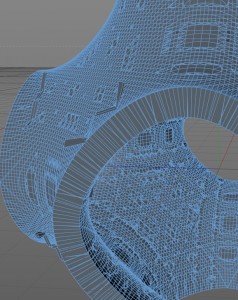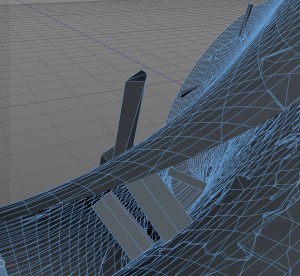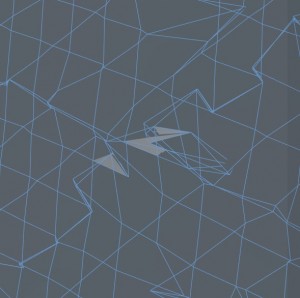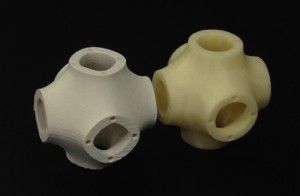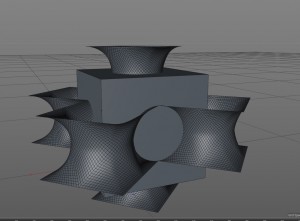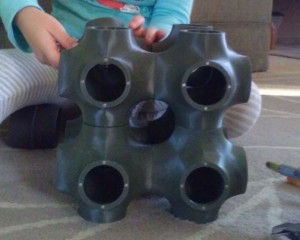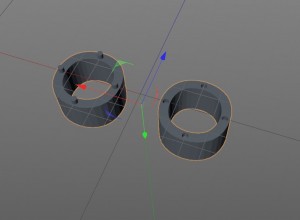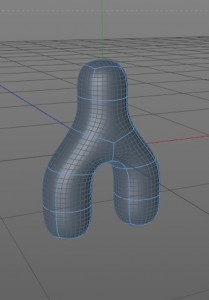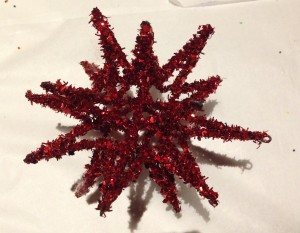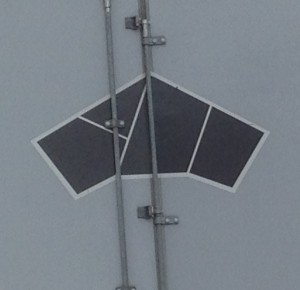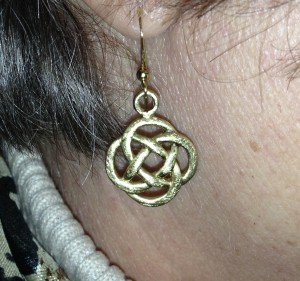In an earlier post on the mathematics of the Schwarz P surface, we saw how minimal surfaces can be understood by viewing them as soap films. The final challenge was to construct a 3D printed soap film frame for the Schwarz P surface for the Taping Shape* exhibit at the Rueben H. Fleet Science Center.
From the way the Schwarz P surface is constructed, we know the boundaries of the 4-gons lie in the surface. Thus the surface has many straight lines lying in it. There are also many circles (really almost circles) lying in the surface.  To construct a soap film frame in Cinema4D, I simply took these lines and circles and thickened them to get the frame. To prevent interior intersections of the tubes, I used the Boole tool (\(A\cup B\)) as I added in the lines and circles. In essence, this takes the “skin” of the two surfaces and ignores what is inside. The last time I used the Boole tool the surface vanished – it was too much for the program to render. However, by deselecting the High Quality option in the Boole options we were able to get the model to appear. I made three sizes of models: 6cmx6cmx6cm,10cmx10cmx10cm, and 15cmx15cmx15cm. I also made these sizes with two different tube diameters: 2.5mm and 3mm.
To construct a soap film frame in Cinema4D, I simply took these lines and circles and thickened them to get the frame. To prevent interior intersections of the tubes, I used the Boole tool (\(A\cup B\)) as I added in the lines and circles. In essence, this takes the “skin” of the two surfaces and ignores what is inside. The last time I used the Boole tool the surface vanished – it was too much for the program to render. However, by deselecting the High Quality option in the Boole options we were able to get the model to appear. I made three sizes of models: 6cmx6cmx6cm,10cmx10cmx10cm, and 15cmx15cmx15cm. I also made these sizes with two different tube diameters: 2.5mm and 3mm.
Printing the model was another question entirely. We had many fails (two shown below) before we figured out how to print the frame.
In essence, the unsupported parts of the model vibrate when the printer’s extruder is going over them. This leads to the frame being “fuzzy”, and even having visible jumps at some points. The solution was relatively simple. When printing, we selected to have the tubes print as a solid, and we also made sure the entire model had supports. The photo below on the left shows the supports for the uPrint SE print, the one on the right shows the 6cm size 3mm diameter frame printed by the MakerBot 2X replicator.
We found that when we dipped model in soapy water, the soap film gave a lovely approximation of the Schwarz P surface.
 The frame has a lot of symmetry too. There are many interesting viewpoints, for example as shown on the right by a 10cm size 2.5mm diameter print by the uPrint SE. You can find the files for the model here on Thingiverse.
The frame has a lot of symmetry too. There are many interesting viewpoints, for example as shown on the right by a 10cm size 2.5mm diameter print by the uPrint SE. You can find the files for the model here on Thingiverse.
*The Taping Shape exhibit is part of the InforMath project funded by the National Science Foundation (DRL-1323587). (The InforMath Project is a partnership between San Diego State University and several museums at the Balboa Park, including the Rueben H. Fleet Science Center .)








